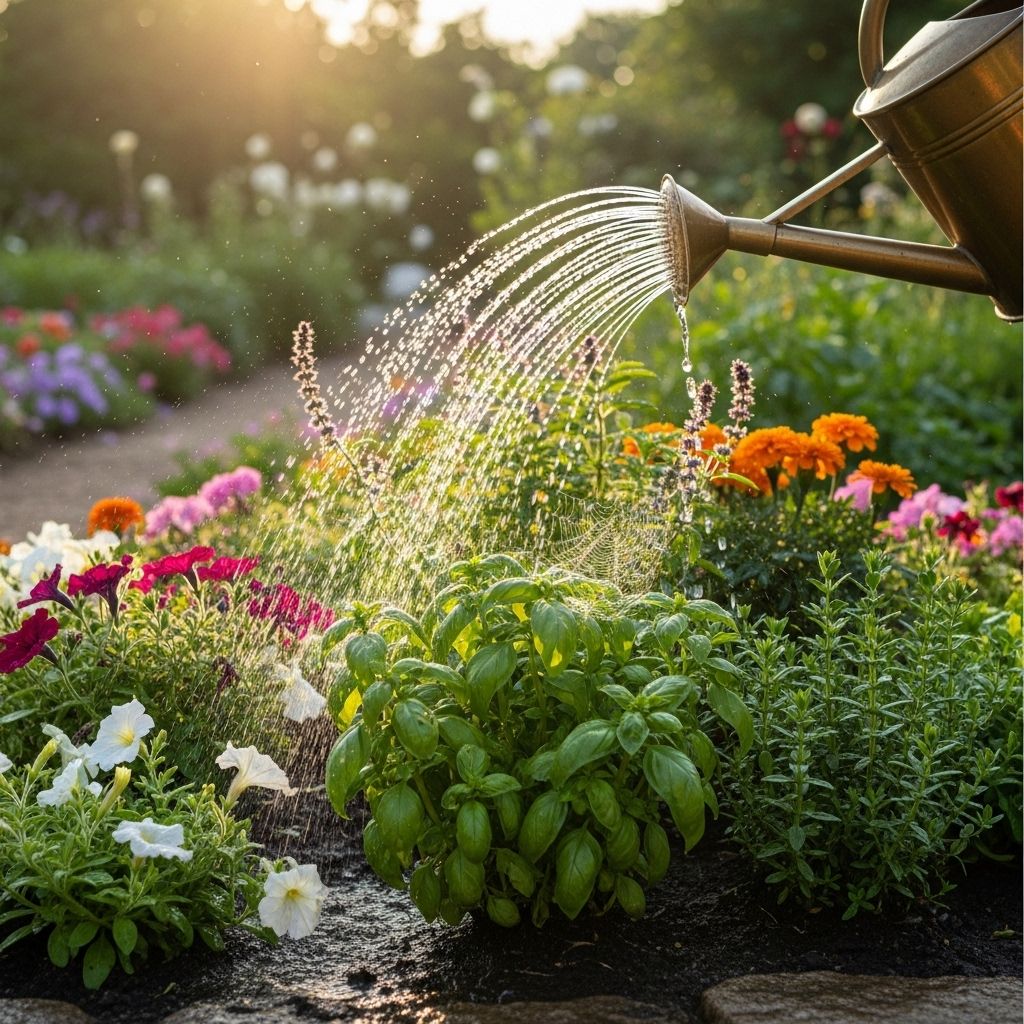Summer Garden Watering Tips: 13 Expert Techniques
Master the art of efficient summer watering to keep your garden thriving through heat waves

Image: HearthJunction Design Team
Essential Summer Garden Watering Guide: 13 Expert Tips
When summer temperatures soar, proper watering becomes the lifeline for your garden. Knowing when, how, and how much to water can mean the difference between a thriving landscape and stressed, struggling plants. This comprehensive guide provides essential strategies to maintain a lush garden throughout the hottest months while conserving water and promoting plant health.
Understanding Plant Water Needs in Summer
Summer presents unique challenges for garden watering. High temperatures, intense sunlight, and dry conditions all increase plant water requirements. Different plants have varying water needs, and understanding these differences is key to efficient garden management.
During hot weather, plants lose moisture through transpiration at accelerated rates. This natural cooling process helps plants survive heat stress but requires adequate water replacement. Without proper watering, plants become dehydrated, leading to wilting, leaf scorch, stunted growth, and even death in extreme cases.
The number of leaves on a plant directly influences how much water it consumes. Plants with larger leaf surfaces transpire more moisture and therefore require more frequent watering compared to those with smaller or fewer leaves. This principle helps explain why certain plants struggle more during heat waves than others.
When to Water Your Garden in Summer
Early Morning Watering
The optimal time to water your garden is early morning, ideally between 5:00 and 9:00 AM. Morning watering offers several significant advantages:
- Less water is lost to evaporation as temperatures are cooler
- Plants have access to moisture throughout the hot day ahead
- Foliage has time to dry before evening, reducing disease risk
- Water pressure is typically higher in the morning, improving irrigation efficiency
Evening Watering Considerations
If morning watering isn’t possible, late afternoon or early evening (4:00-6:00 PM) is the next best option. This timing allows foliage to dry before nightfall while still giving plants access to moisture during cooler evening hours. Avoid watering after sunset as prolonged moisture on leaves overnight can promote fungal diseases and attract pests.
Avoiding Midday Watering
Watering during the midday heat (10:00 AM to 3:00 PM) is generally inefficient and potentially harmful. During these hours:
- Up to 30% of water can be lost to evaporation before reaching plant roots
- Water droplets on leaves can act as magnifying glasses, intensifying sunlight and causing leaf burn
- Rapid temperature changes when cool water hits hot plants can cause shock
How Often to Water Your Summer Garden
Rather than sticking to a rigid schedule, adapt your watering frequency based on weather conditions, soil type, and plant needs. As a general guideline, most established gardens benefit from one thorough watering per week, delivering approximately one inch of water. However, during extreme heat waves or for certain plants, you may need to water every three to four days.
Prioritize your watering efforts on plants with the highest needs:
- Seedlings and newly planted specimens
- Container plants (may need daily watering in extreme heat)
- Vegetables during critical growth stages (especially when flowering and fruiting)
- Plants with shallow root systems
- Moisture-loving species like lobelia and hydrangeas
Established trees and shrubs, particularly native and drought-tolerant varieties, generally require less frequent watering as their deeper root systems can access moisture from lower soil levels.
Efficient Watering Techniques
Water at the Base
Direct water to the base of plants rather than spraying foliage. This ensures the water reaches the root zone where it’s needed most. Wet foliage can promote fungal diseases and leads to water waste through evaporation. Use tools like watering wands, long-neck watering cans, soaker hoses, or drip irrigation systems to deliver water precisely to plant roots.
Deep, Infrequent Watering
One thorough watering that penetrates deeply into the soil is far more beneficial than frequent, shallow watering. Deep watering encourages roots to grow downward, creating stronger plants with better drought resilience. Shallow watering promotes surface root development, making plants more vulnerable to heat and dry conditions.
To ensure effective deep watering:
- Water slowly to allow proper soil absorption
- Continue until moisture has penetrated 6-8 inches deep
- Use a soil probe or trowel to check moisture depth
- Allow soil to dry slightly between waterings
Mulch to Retain Moisture
Applying a 2-3 inch layer of mulch around plants significantly reduces water loss through evaporation and helps maintain consistent soil moisture. Organic mulches like wood chips, shredded bark, compost, or straw not only conserve water but also:
- Keep soil temperatures cooler
- Suppress weed growth
- Add nutrients to soil as they decompose
- Improve soil structure over time
When applying mulch, keep it 1-2 inches away from plant stems and tree trunks to prevent rot and pest problems.
Choosing the Right Watering Equipment
Selecting appropriate watering tools enhances efficiency and plant health. Consider these options for different areas of your garden:
| Watering Method | Best For | Efficiency | Pros & Cons |
|---|---|---|---|
| Drip Irrigation | Vegetable gardens, flower beds, shrubs | 90-95% | Precise delivery, minimal evaporation; requires initial setup |
| Soaker Hoses | Row plantings, perennial beds | 80-90% | Easy to install, good for established beds; less precise than drip |
| Watering Wands | Container plants, new transplants | 70-80% | Targeted watering, gentle flow; time-consuming for large areas |
| Sprinklers | Lawns, large areas | 50-70% | Covers large spaces; high evaporation loss, wets foliage |
Smart Irrigation Controllers
Consider upgrading to smart irrigation controllers that adjust watering schedules based on weather conditions. These systems can include rain sensors, soil moisture monitors, or weather-based controls that automatically skip watering during or after rainfall. Smart controllers can reduce water waste by 15-30% while improving plant health through optimized irrigation.
Water Conservation Strategies
Implementing water-wise practices not only conserves a precious resource but also promotes healthier plants and reduces maintenance.
Collect Rainwater
Harvesting rainwater provides a free, chemical-free water source for your garden. Install rain barrels or cisterns to collect runoff from roofs. Even modest systems can capture significant amounts of water during summer storms. Most vegetables and ornamental plants actually prefer rainwater to treated tap water because it contains no chlorine and has a balanced pH.
Group Plants by Water Needs
Practice hydrozoning by arranging plants with similar water requirements together. This allows for more efficient irrigation and prevents overwatering drought-tolerant plants or underwatering those with higher moisture needs. Create designated zones in your garden:
- High water zone: Vegetables, annuals, and moisture-loving perennials
- Moderate water zone: Most perennials, small shrubs, and young trees
- Low water zone: Established native plants and drought-tolerant species
Improve Soil Structure
Healthy soil with good structure retains moisture more effectively while still allowing proper drainage. Add organic matter like compost to your garden beds annually to improve water retention, especially in sandy soils. For clay soils, organic amendments help improve drainage while still maintaining adequate moisture levels for plant roots.
Signs of Watering Problems
Learning to recognize water stress indicators helps fine-tune your irrigation practices:
Underwatering Signs
- Wilting that doesn’t recover in the evening
- Curling or yellowing leaves, particularly at edges
- Slow growth or limited flower/fruit production
- Dry, cracking soil pulling away from container edges
Overwatering Signs
- Yellowing leaves, particularly lower ones
- Soft, mushy stems near soil level
- Fungal growth or algae on soil surface
- Stunted growth despite adequate fertilization
- Foul odors from soil indicating root rot
Drought-Tolerant Gardening
Incorporating drought-resistant plants reduces watering demands while maintaining an attractive landscape. Many native and adapted species thrive with minimal supplemental irrigation once established. Consider plants like lavender, Russian sage, sedums, yarrow, and ornamental grasses for low-water areas of your garden.
When selecting drought-tolerant plants, look for these characteristics:
- Silver or gray foliage that reflects sunlight
- Small, thick, or waxy leaves that reduce water loss
- Deep root systems that access subsoil moisture
- Natural habitat similar to your local climate
Even drought-tolerant plants require regular watering during their establishment period (typically the first year). After establishment, gradually reduce watering frequency to encourage deep root development.
Frequently Asked Questions
Q: How can I tell if my plants need water?
A: Check soil moisture 2-3 inches below the surface. If it feels dry at that depth, it’s time to water. Also look for visual cues like slight wilting, dull foliage, or curling leaves. For container plants, lift the pot—significantly lighter weight indicates dry soil.
Q: Should I water my lawn differently from my garden beds?
A: Yes. Lawns benefit from deep, infrequent watering that encourages deep root growth. Water to a depth of 6 inches, typically applying about 1-1.5 inches of water per week, adjusting for rainfall. Early morning watering (4-10 AM) is ideal for lawns to minimize disease and evaporation.
Q: How should I water newly planted trees and shrubs?
A: New woody plants need regular watering throughout their first two growing seasons. Create a watering basin around the root ball and fill it slowly 2-3 times per week during hot weather. Gradually extend the watering area as roots grow outward and reduce frequency as plants establish.
Q: Is it better to use sprinklers or drip irrigation?
A: Drip irrigation is significantly more efficient for garden beds, delivering water directly to plant roots with minimal waste. Sprinklers are appropriate for lawns but lose more water to evaporation and runoff. When possible, convert garden beds from sprinkler to drip systems to improve water efficiency by 30-50%.
Q: How do I water container plants effectively in summer?
A: Container plants dry out quickly in hot weather and may need daily watering. Water thoroughly until excess drains from the bottom of the pot. Using larger containers, adding water-retaining polymers to potting mix, and grouping containers together can help reduce watering frequency.
By implementing these summer watering strategies, you’ll cultivate a resilient garden that thrives even during the most challenging heat waves. Remember that proper watering is as much about observation and adaptation as it is about following guidelines. Pay attention to your plants’ responses and adjust your practices accordingly for a flourishing summer landscape.
References
- https://www.gardendesign.com/how-to/summer-watering.html
- https://www.gardenersworld.com/plants/guide-to-summer-watering/
- https://www.realsimple.com/ideal-summer-watering-schedule-8682011
- https://stories.tamu.edu/news/2023/07/07/know-when-and-how-to-water-your-lawn-and-garden-this-summer/
- https://www.dcwater.com/sites/default/files/landscape%20guide.pdf
Read full bio of Srija Burman












